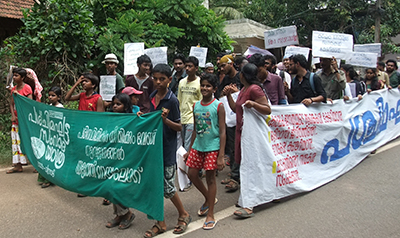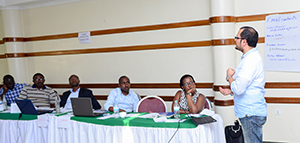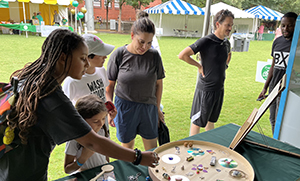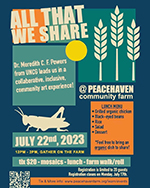Environmental social work might appear to be a relatively new addition to social work education, research and practice, but think again.

Concerns about how people are affected by their environment—social, physical or other—date back to social work pioneers like Jane Addams in the 1890s and early 1900s. “It’s definitely been within social work the entire time,” says Dr. Meredith C. F. Powers, associate professor, University of North Carolina-Greensboro Social Work Department. “For people like myself, we had a shift, an awakening—like maybe we should consider this and not be so human-centered.” Pictured at left: For his new book, "Uncommon Cause: Living for Environmental Justice in Kerala," Dr. John Mathias of Florida State University spent three years in India studying how community organizers there address environmental issues. Here, participants in a 50-day-long "Dialogue Journey" march to raise awareness about environmental degradation in the rainforests of Kerala's Western Ghats mountain range.
Seeking Environmental Justice

One key focus has been environmental justice. “It’s been well documented that people who are more marginalized have less access to decision-making authority about what’s built in their communities—such as a trash dump—or how closely it is monitored or policed for a spill or when dangerous chemicals are released,” says Dr. Amy Krings, associate professor, Ohio State University College of Social Work. Or a Latino community might be set in a flood plain. Or an African-American neighborhood might be next to an oil refinery. Pictured at right: Dr. Praveen Kumar of Boston College conducts a workshop in Kigali, Rwanda, for local communities on helping people in the Kigeme refugee camp adopt cleaner cooking systems.
Beyond this “built environment,” says Dr. Shanondora Billiot, assistant professor at Arizona State University School of Social Work and native of south Louisiana, when a hurricane or other natural disaster hits “it doesn’t matter your wealth or your state of being—everyone is exposed. Instead, it’s a matter of how people are able to cope with it financially, socially, everything.”
Gaining Professional Recognition

In 2010, environmental social work got a boost when the International Federation of Social Work added “climate justice” to its Global Agenda for 2010-2020. Later, NASW began producing webinars and other materials promoting environmental justice. Pictured at left: UNC-Greensboro's Dr. Meredith Powers leads an ongoing "community-engaged," environmentally oriented research project called "All That We Share," which celebrates North Carolina's refugee and other diverse communities through workshops and creating "eco-art" such as mosaics.
In 2015, environmental concerns sparked one of social work’s new Grand Challenges—“Creating Social Responses to a Changing Environment.” The initial challenge behind this particular Grand Challenge has been spreading the word about its value among fellow social workers, says Dr. Lisa Reyes Mason, associate professor and interim dean, University of Denver Graduate School of Social Work, who was co-lead for five years. Current co-lead Dr. John Mathias, associate professor, Florida State University College of Social Work, adds that “a lot of it has been about building an awareness in social work that environmental issues are social issues, and building the capacity in both education and research [see bottom of p. 53] to really start expanding social work’s contribution here.”
Probably the strongest catalyst education-wise also came in 2015 when the Council on Social Work Education added environmental justice to its competencies, or EPAS (Education Policies and Accreditation Standards).
Environmental Social Work Education 101
At the University of Denver, environmentally focused material is now “infused” across the MSW curriculum so that, for instance, in a direct-practice class, “when covering introductory assessments with a new client you’re also including questions about environmental hazards in the home or issues related to extreme weather—summer heat, extreme cold, soaring energy bills,” says Mason. Similarly, Florida State’s MSW program has incorporated environmental justice into such foundation courses as “Human Behavior and the Social Environment,” says Mathias.

Dedicated environmental social work courses have also been springing up. UNC-Greensboro has “Environmental Justice” for both BSW and MSW students. (The MSW program is a partnership with the North Carolina Agricultural and Technical State University Department of Social Work.) Pictured at right: Promoting eco-collaboration at UNC-Greensboro.
At the Boston College School of Social Work, associate professor Dr. Praveen Kumar, who’s also a current environmental Grand Challenge co-lead, developed the multidisciplinary course “Climate Change and Environmental Justice: Implications for Social Work.” In addition to MSW students, he says, “I get registrations from the schools of Management, Nursing, Education, Economics and others.”
Meanwhile, the University of Denver Graduate School of Social Work offers “Social and Environmental Impact Assessment” and “Creating a Regenerative Future.”
Field opportunities have been another way for students to expand their understanding of environmental impacts. At Florida State, says Mathias, MSW students worked with high school students in Florida’s Calhoun County following Hurricane Michael in 2018, helping them process their often-traumatic experiences and map out where they saw resiliency or vulnerability in their communities. And at UNC-Greensboro, one BSW student who helped out at Cone Health Foundation’s cancer center tending a new garden was later hired to make the garden an eco-therapy space, says Powers. “So it may have looked like hospital social work, but really it turned into an environmentally focused field opportunity.”
There’s no question that interest in environmental social work is growing, Mason says. “When I started my PhD in 2008, it was hard to find a mentor in this area. And now, we have so many.”
Just don’t call it a niche, according to Powers. “It’s not a specialty like medical social work. Instead, it should be infused in every aspect of social work, in every population, in every topic, and then through a lens of understanding eco-social worldviews.”
Visit CSWE’s “Curricular Guide for Environmental Justice” for information.
Growing the Environmental Social Work Research
Throughout the history of environmental social work, studies like Cacel B. Germain’s “An Ecological Perspective in Casework Practice” (1973), with its emphasis on “person in environment,” have regularly broken new ground.
Still, environmental social work has lagged in acceptance by the social work profession overall, says Dr. Amy Krings, associate professor at the Ohio State University College of Social Work, who is a co-lead of the environmental Grand Challenge—“Creating Social Responses to a Changing Environment”—so building a larger research infrastructure has been vital.
Adds Dr. John Mathias, associate professor at the Florida State University College of Social Work and also a co-lead of the environmental Grand Challenge, “A lot of the research going on in environmental social work is multidisciplinary, collaborative work where the focus is on the social justice, community engagement and human impact components of various environmental issues.”
Following are recent samples from the burgeoning research in environmental social work:
- “Climate Change, Social Work, and the Transition Away from Fossil Fuels: A Scoping Review” by Lisa Reyes Mason, Colleen Cummings Melton, Darian Gray and Andrea Lynn Swallow
- “Co-Creating a ‘Sustainable New Normal’ for Social Work and Beyond: Embracing an Ecosocial Worldview” by Meredith Powers, Michaela Rinkel and Praveen Kumar
- “Ecosocial Work and Social Change in Community Practice” by Komalsingh Rambaree, Meredith C. F. Powers
and Richard J. Smith
- “Environmental Social Work in the Disciplinary Literature, 1991-2015” by Amy Krings, Bryan G Victor, John Mathias and Brian E. Perron
- “Indigenous Perspectives for Strengthening Social Responses to Global Environmental Changes: A Response to the Social Work Grand Challenge on Environmental Change” by Shanondora Billiot, Ramona Beltrán, Danica Brown, Felicia M. Mitchell and Angela Fernandez
- “Utilizing Photovoice to Support Indigenous Accounts of Environmental Change and Injustice” by Felicia M. Mitchell, Shanondora Billiot and Stephanie Lechuga-Peña